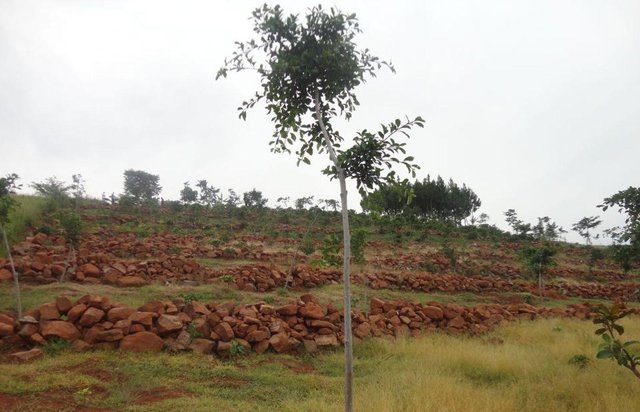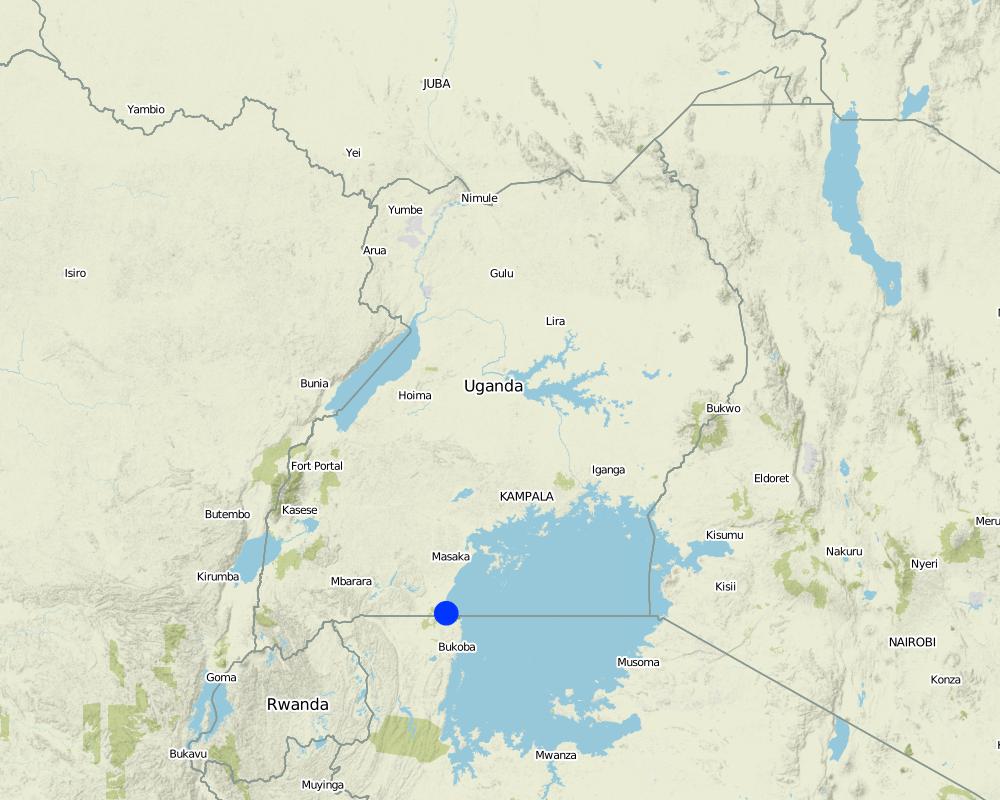FFS/SLM Community Initiative [ยูกันดา]
- ผู้สร้างสรรค์:
- การอัพเดท:
- ผู้รวบรวม: Wilson Bamwerinde
- ผู้เรียบเรียง: –
- ผู้ตรวจสอบ: Fabian Ottiger
Farmer Field School
approaches_2487 - ยูกันดา
ดูส่วนย่อย
ขยายทั้งหมด ย่อทั้งหมด1. ข้อมูลทั่วไป
1.2 รายละเอียดที่ติดต่อได้ของผู้รวบรวมและองค์กรที่เกี่ยวข้องในการประเมินและการจัดเตรียมทำเอกสารของแนวทาง
1.3 เงื่อนไขที่เกี่ยวข้องกับการใช้ข้อมูลที่ได้บันทึกไว้ผ่านทาง WOCAT
วันที่เก็บรวบรวมข้อมูล (ภาคสนาม):
13/12/2013
ผู้รวบรวมและวิทยากรหลักยอมรับเงื่อนไขเกี่ยวกับการใช้ข้อมูลที่ถูกบันทึกผ่านทาง WOCAT:
ใช่
1.4 การอ้างอิงถึงแบบสอบถามเรื่องเทคโนโลยี SLM

Stone lines [ยูกันดา]
Stone lines are built along a contour to control soil erosion on a degraded steep slope.
- ผู้รวบรวม: Wilson Bamwerinde
2. คำอธิบายของแนวทาง SLM
2.1 การอธิบายแบบสั้น ๆ ของแนวทาง
Farmers are organized to promote adoption of sustainable land management best practices within the community
2.2 การอธิบายอย่างละเอียดของแนวทาง
การอธิบายอย่างละเอียดของแนวทาง:
Aims / objectives: To train farmers in land based technologies that improve productivity, land management and are resilient to climate changes
Methods: Planning meetings, agro-ecosystem analysis (AESA), farmer-to-farmer visits, monitoring and evaluation
Stages of implementation: Farmer Field School (FFS) formation to bring together 30 farmers from a catchment area; training in group dynamics; training in best practices to address land degradation problems; AESA; and action planning
Role of stakeholders: District facilitators: Facilitation of FFS formation, training of trainers for AESA, drawing village land use plans, prioritizing enterprises/challenges, making technical recommendations; Local leaders: Passing and implementing bye-laws.
2.5 ประเทศ ภูมิภาค หรือสถานที่ตั้งที่ได้นำแนวทางไปใช้
ประเทศ:
ยูกันดา
ภูมิภาค/รัฐ/จังหวัด: :
Uganda
ข้อมูลเฉพาะเพิ่มเติมของสถานที่ตั้ง:
Kijonjo, Katongero, Rakai District
Map
×2.6 วันที่เริ่มต้นและสิ้นสุดของแนวทาง
ระบุปีที่เริ่ม:
2011
การสิ้นสุดลง (ถ้าแนวทางไม่ได้ใช้อีกต่อไป):
2015
2.7 ประเภทของแนวทาง
- ใช้โครงงานหรือแผนงานเป็นฐาน
2.8 เป้าหมายหรือวัตถุประสงค์หลักของแนวทาง
The Approach focused on SLM only (Sustainable Land Management Farmer Cooperative)
To share knowledge, skills and information on establishment of local best practices to improve productivity and biodiversity and reduce soil erosion
The SLM Approach addressed the following problems: Low soil nutrient levels, vegetation loss and soil erosion on steep slopes
2.9 เงื่อนไขที่เอื้ออำนวยหรือเป็นอุปสรรคต่อการนำเทคโนโลยีภายใต้แนวทางนี้ไปปฏิบัติใช้
การมีไว้ให้หรือการเข้าถึงแหล่งการเงินและบริการ
- เป็นอุปสรรค
Inadequate resources because farming is mainly subsistent
Treatment through the SLM Approach: Farmers formed cooperatives to pool resources
ความรู้เกี่ยวกับ SLM การเข้าถึงการสนับสนุนด้านเทคนิค
- เป็นอุปสรรค
Little available information on addressing land management issues
Treatment through the SLM Approach: Trained facilitators were sourced to provide appropriate knowledge to address relevant constraints
ปริมาณงานที่ทำได้ กำลังคนที่มีให้
- เป็นอุปสรรค
Increased workload required in the implementation caused expenses on hired labor to rise.
Treatment through the SLM Approach: Sharing workload through working together to dig up stones and carry them on steep slopes, lay them along contours and plant Ficus natalensis to stabilize the soil
3. การมีส่วนร่วมและบทบาทของผู้มีส่วนได้ส่วนเสียที่เกี่ยวข้อง
3.1 ผู้มีส่วนได้ส่วนเสียที่เกี่ยวข้องในแนวทางนี้และบทบาท
- ผู้ใช้ที่ดินระดับท้องถิ่นหรือชุมชนระดับท้องถิ่น
Women constitute the majority of farmers in attendance because most agricultural production in the district is carried out by women, except in cattle-keeping areas where men are the majority
- ผู้เชี่ยวชาญ SLM หรือที่ปรึกษาการเกษตร
- รัฐบาลระดับท้องถิ่น
District facilitators were provided by the district local government
- รัฐบาลแห่งชาติ (ผู้วางแผน ผู้ทำการตัดสินใจ)
Collaboration with the line Central Government Ministries through the Project Steering Committee at Permanent Secretary level
- องค์การระหว่างประเทศ
Kagera TAMP (FAO-GEF) provided funding for specialist facilitators
ถ้ามีผู้มีส่วนได้ส่วนเสียหลายคนที่เกี่ยวข้องให้ระบุหน่วยงานตัวแทน:
Kagera TAMP international specialists with the help of national FFS specialists
3.2 การเกี่ยวข้องของผู้ใช้ที่ดินระดับท้องถิ่นหรือชุมชนระดับท้องถิ่นในช่วงต่างๆของแนวทาง
| ความเกี่ยวข้องของผู้ใช้ที่ดินระดับท้องถิ่นหรือชุมชนระดับท้องถิ่น | ระบุผู้ที่มีส่วนเกี่ยวข้องและอธิบายกิจกรรม | |
|---|---|---|
| การริเริ่มหรือการจูงใจ | ปฏิสัมพันธ์ | FFS specialist facilitator with prospective FFS members to get farmers organized in FFS (30 members each) |
| การวางแผน | ปฏิสัมพันธ์ | Farmers in their farmer field schools sketched watershed maps and developed action plans with the help of district facilitators |
| การดำเนินการ | ปฏิสัมพันธ์ | Facilitators helped FFS members in the dynamics that sustained and strengthened the Approach |
| การติดตามตรวจสอบหรือการประเมินผล | ไม่ลงมือ | A few members were co-opted to the monitoring team which comprised local government facilitators, Kagera TAMP Project specialists and the central government Project Steering Committee |
| Research | ปฏิสัมพันธ์ | FFS members carried out Agro-ecosystem Analysis (AESA) with training and field support from specialists |
3.4 การตัดสินใจเลือกใช้เทคโนโลยี SLM
ระบุผู้ที่ทำการตัดสินใจเลือกเทคโนโลยีมากกว่าหนึ่งวิธีไปปฏิบัติใช้:
- ผู้ใช้ที่ดินเป็นผู้ตัดสินใจหลัก โดยการสนับสนุนจากผู้เชี่ยวชาญ SLM
การอธิบาย:
The FFS concept and methodology were introduced to the farmers by SLM specialists. The decisions on technology choice were the result of discussions bf the farmers with support from the specialists.
Decisions on the method of implementing the SLM Technology were made by mainly by land users supported by SLM specialists. Farmers in the FFS decided how to overcome constraints posed by their hilly terrain and high cost of labor
4. การสนับสนุนด้านเทคนิค การสร้างขีดความสามารถ และการจัดการด้านความรู้
4.1 การสร้างขีดความสามารถ / การอบรม
ได้มีการจัดอบรมให้แก่ผู้ใช้ที่ดินหรือผู้มีส่วนได้ส่วนเสียคนอื่น ๆ หรือไม่:
ใช่
ให้ระบุว่าใครเป็นผู้ได้รับการอบรม:
- ผู้ใช้ที่ดิน
- เจ้าหน้าที่ภาคสนาม / ที่ปรึกษา
- Politicians/Policy Makers
รูปแบบการอบรม:
- กำลังดำเนินการ
- เกษตรกรกับเกษตรกร
- ใช้พื้นที่ทำการสาธิต
- จัดการประชุมสู่สาธารณชน
หัวข้อที่พูด:
Extension Training: use of demonstration plots and AESA to experiment and discover the appropriate methodology for implementation of SLM technologies. A formal session involves a facilitator and farmers. The facilitator guides the farmers on how to investigate a problem using marker-drawn sketches on flip chart. Observations, conclusions and recommendations are reached in a participatory manner.
Extension: FFS members adopt a resolution to carry out the recommended procedures/activities; community members are free to interact with FFS members on field days and copy recommendations. Farmer-to-farmer visits are encouraged and promoted to extend information.
Research: FFS members research together on a given problem/challenge such as soil fertility and arrive at recommendations together. They are guided by facilitators from government or government research institutions with collaborative support from Kagera TAMP/FAO project.
Importance of land use rights: Ownership of land affects land management practices. The attitude towards the recommendation by farmers is usually determined by the FFS members. In Kagera TAMP districts land ownership is customary but the right to use land is governed by national laws.
Incentives:
Labor: Farmer Field School members provide the labor to implement technologies. Hired labor may also be used.
Inputs: Farmers provide the basic tools such as hoes, pick axe etc. Seedlings and seeds may be provided by the project.
Credit: Small amounts may be acquired from the FFS cooperative savings.
4.3 การเสริมความแข็งแกร่งให้กับสถาบัน (การพัฒนาองค์กร)
สถาบันได้รับการจัดตั้งขึ้นมาหรือเสริมความแข็งแกร่งโดยแนวทางนี้หรือไม่:
- ใช่ อย่างมาก
ระบุระดับของสถาบันที่ได้รับการเสริมความแข็งแกร่งหรือจัดตั้งขึ้นมา:
- ท้องถิ่น
ระบุประเภทของการให้ความช่วยเหลือสนับสนุน:
- การสร้างขีดความสามารถ / การอบรม
- อุปกรณ์
ให้รายละเอียดเพิ่มเติม :
Training workshops in Sustainable Land Management (SLM) and Land Degradation Assessment (LADA) both national and international, seminars, and procurement and training in the use of computers, digital cameras and GPS units
4.4 การติดตามตรวจสอบและประเมินผล
การติดตามตรวจสอบและประเมินผลเป็นส่วนหนึ่งของแนวทางหรือไม่:
ใช่
ความคิดเห็น:
bio-physical aspects were regular monitored by project staff, government, land users through observations; indicators: Measurement of crop yield, soil nutrients, biodiversity
bio-physical aspects were regular monitored by project staff, government, land users through measurements; indicators: Measurement of crop yield, soil nutrients, biodiversity
economic / production aspects were regular monitored by government, land users through observations; indicators: Measurement of crop yield, vigor
economic / production aspects were regular monitored by government through measurements; indicators: Measurement of crop yield, vigor
area treated aspects were regular monitored by project staff, government through observations; indicators: Measure by attendance, morale
area treated aspects were regular monitored by project staff, government through measurements; indicators: Measure by attendance, morale
no. of land users involved aspects were regular monitored by project staff through observations; indicators: None
no. of land users involved aspects were regular monitored by project staff through measurements; indicators: None
management of Approach aspects were None monitored by project staff through observations; indicators: None
management of Approach aspects were None monitored by project staff through measurements; indicators: None
There were few changes in the Approach as a result of monitoring and evaluation: FFS constantly refines and improves on what and how to achieve objectives, to discover and archive best practices in the most effective forms possible
There were few changes in the Technology as a result of monitoring and evaluation: Height of stone lines, width between lines
4.5 การวิจัย
การวิจัยเป็นส่วนหนึ่งของแนวทางหรือไม่:
ใช่
ระบุหัวข้อเรื่อง:
- นิเวศวิทยา
ให้ข้อมูลเพิ่มเติมและให้ระบุผู้ทำการวิจัย:
Agro-ecosystem Analysis (AESA) by FFS members
Research was carried out on-farm
5. การสนับสนุนด้านการเงินและวัสดุอุปกรณ์
5.1 ระบุงบประมาณประจำปีสำหรับแนวทาง SLM นี้
ถ้าหากว่างบประมาณประจำปีไม่เป็นที่ทราบแน่นอน ให้ระบุช่วงลงไป:
- < 2,000
แสดงความคิดเห็น (แหล่งของการระดมทุน ผู้บริจาคคนสำคัญ):
Approach costs were met by the following donors: international (Kagera TAMP): 18.95%; local government (district, county, municipality, village etc) (District and Sub-county facilitator time): 11.14%; local community / land user(s) (Land users as FFS members): 69.91%
5.2 การสนับสนุนด้านการเงิน / วัสดุอุปกรณ์ให้แก่ผู้ใช้ที่ดิน
ผู้ใช้ที่ดินได้รับการสนับสนุนด้านการเงิน / วัสดุอุปกรณ์ไปปฏิบัติใช้เทคโนโลยีหรือไม่:
ไม่ใช่
5.3 เงินสนับสนุนสำหรับปัจจัยนำเข้า (รวมถึงแรงงาน)
ถ้าแรงงานโดยผู้ใช้ที่ดินเป็นปัจจัยนำเข้าที่มีอยู่มากมาย ระบุด้วยว่าเนื่องจาก:
- สมัครใจ
ความคิดเห็น:
FFS members were facilitated with information and they carried out the approach without any financial or material support
5.4 เครดิต
มีการจัดหาเครดิตมาให้ภายใต้แนวทาง SLM หรือไม่:
ไม่ใช่
6. การวิเคราะห์ผลกระทบและการสรุป
6.1 ผลกระทบของแนวทาง
ช่วยให้ผู้ใช้ที่ดินนำเอาเทคโนโลยี SLMไปใช้และบำรุงรักษาสภาพไว้ได้หรือไม่:
- ไม่ใช่
- ใช่ เล็กน้อย
- ใช่ ปานกลาง
- ใช่ อย่างมาก
Formerly disused land was made productive
Did other land users / projects adopt the Approach?
- ไม่ใช่
- ใช่ เล็กน้อย
- ใช่ ปานกลาง
- ใช่ อย่างมาก
Did the Approach lead to improved livelihoods / human well-being?
- ไม่ใช่
- ใช่ เล็กน้อย
- ใช่ ปานกลาง
- ใช่ อย่างมาก
Crop diversification, food security
Did the Approach help to alleviate poverty?
- ไม่ใช่
- ใช่ เล็กน้อย
- ใช่ ปานกลาง
- ใช่ อย่างมาก
FFS savings and credit cooperative helping members to access small unsecured agro-input financing
6.2 แรงจูงใจหลักของผู้ใช้ที่ดินเพื่อที่จะนำ SLM ไปปฏิบัติใช้
- การผลิตที่เพิ่มขึ้น
- กำไร (ความสามารถ) อัตราส่วนค่าใช้จ่ายต่อผลประโยชน์ที่เพิ่มขึ้น
- จิตสำนึกด้านสิ่งแวดล้อม
6.3 ความยั่งยืนของกิจกรรมของแนวทาง
ผู้ใช้ที่ดินสามารถทำให้สิ่งต่างๆ ที่ได้ปฏิบัติใช้โดยแนวทางนี้ยั่งยืนได้หรือไม่ (โดยไม่มีการสนับสนุนจากภายนอก):
- ใช่
ลิงก์และโมดูล
ขยายทั้งหมด ย่อทั้งหมดลิงก์

Stone lines [ยูกันดา]
Stone lines are built along a contour to control soil erosion on a degraded steep slope.
- ผู้รวบรวม: Wilson Bamwerinde
โมดูล
ไม่มีโมดูล


